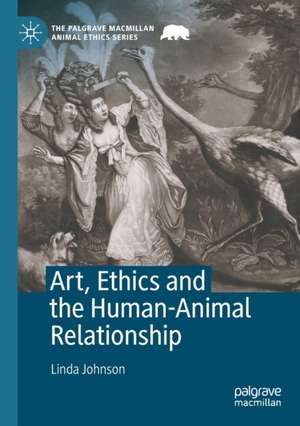Art, Ethics and the Human-Animal Relationship: The Palgrave Macmillan Animal Ethics Series
Autor Linda Johnsonen Limba Engleză Paperback – 22 sep 2022
| Toate formatele și edițiile | Preț | Express |
|---|---|---|
| Paperback (1) | 696.18 lei 6-8 săpt. | |
| Springer International Publishing – 22 sep 2022 | 696.18 lei 6-8 săpt. | |
| Hardback (1) | 701.59 lei 6-8 săpt. | |
| Springer International Publishing – 21 sep 2021 | 701.59 lei 6-8 săpt. |
Din seria The Palgrave Macmillan Animal Ethics Series
- 18%
 Preț: 786.52 lei
Preț: 786.52 lei - 8%
 Preț: 588.33 lei
Preț: 588.33 lei - 8%
 Preț: 538.07 lei
Preț: 538.07 lei - 20%
 Preț: 814.15 lei
Preț: 814.15 lei - 20%
 Preț: 691.09 lei
Preț: 691.09 lei - 17%
 Preț: 524.03 lei
Preț: 524.03 lei -
 Preț: 224.33 lei
Preț: 224.33 lei - 18%
 Preț: 1238.56 lei
Preț: 1238.56 lei - 18%
 Preț: 894.46 lei
Preț: 894.46 lei - 15%
 Preț: 648.24 lei
Preț: 648.24 lei -
 Preț: 384.86 lei
Preț: 384.86 lei - 15%
 Preț: 590.49 lei
Preț: 590.49 lei -
 Preț: 390.63 lei
Preț: 390.63 lei -
 Preț: 482.17 lei
Preț: 482.17 lei -
 Preț: 384.86 lei
Preț: 384.86 lei -
 Preț: 485.24 lei
Preț: 485.24 lei - 18%
 Preț: 883.75 lei
Preț: 883.75 lei - 18%
 Preț: 727.97 lei
Preț: 727.97 lei -
 Preț: 383.93 lei
Preț: 383.93 lei -
 Preț: 380.45 lei
Preț: 380.45 lei - 18%
 Preț: 737.12 lei
Preț: 737.12 lei - 15%
 Preț: 644.18 lei
Preț: 644.18 lei - 15%
 Preț: 698.15 lei
Preț: 698.15 lei -
 Preț: 385.84 lei
Preț: 385.84 lei - 18%
 Preț: 1111.53 lei
Preț: 1111.53 lei -
 Preț: 380.25 lei
Preț: 380.25 lei - 18%
 Preț: 780.82 lei
Preț: 780.82 lei - 15%
 Preț: 700.94 lei
Preț: 700.94 lei - 15%
 Preț: 639.73 lei
Preț: 639.73 lei - 15%
 Preț: 703.52 lei
Preț: 703.52 lei -
 Preț: 414.21 lei
Preț: 414.21 lei - 18%
 Preț: 787.47 lei
Preț: 787.47 lei - 18%
 Preț: 723.24 lei
Preț: 723.24 lei -
 Preț: 379.68 lei
Preț: 379.68 lei -
 Preț: 383.93 lei
Preț: 383.93 lei -
 Preț: 383.12 lei
Preț: 383.12 lei
Preț: 696.18 lei
Preț vechi: 819.03 lei
-15% Nou
Puncte Express: 1044
Preț estimativ în valută:
133.21€ • 139.08$ • 110.25£
133.21€ • 139.08$ • 110.25£
Carte tipărită la comandă
Livrare economică 05-19 aprilie
Preluare comenzi: 021 569.72.76
Specificații
ISBN-13: 9783030788353
ISBN-10: 3030788350
Pagini: 308
Ilustrații: XXV, 308 p. 78 illus., 55 illus. in color.
Dimensiuni: 148 x 210 mm
Greutate: 0.4 kg
Ediția:1st ed. 2021
Editura: Springer International Publishing
Colecția Palgrave Macmillan
Seria The Palgrave Macmillan Animal Ethics Series
Locul publicării:Cham, Switzerland
ISBN-10: 3030788350
Pagini: 308
Ilustrații: XXV, 308 p. 78 illus., 55 illus. in color.
Dimensiuni: 148 x 210 mm
Greutate: 0.4 kg
Ediția:1st ed. 2021
Editura: Springer International Publishing
Colecția Palgrave Macmillan
Seria The Palgrave Macmillan Animal Ethics Series
Locul publicării:Cham, Switzerland
Cuprins
1. Chapter 1: Introduction.- 2. Chapter 2: A New Breed: The Cat as Scapegoat in Edenic and Utopian Imagery.- 3. Chapter 3: Virtue and Vice in High Couture.- 4. Chapter 4: Transformational Approaches: Equine Speciesism.- 5. Chapter 5: Looking Askance: The Changing Shape Of “Meat” In Dutch Still Life Painting.- 6. Chapter 6: Historical Processes: Embodied /Embedded.- 7. Chapter 7: Absent Referents: Bristly Brushes.- 8. Chapter 8: Conclusion: Darkness into Light.-
Recenzii
“This work is a welcome addition to the growing list of scholarly books that take seriously the ways that representations of nonhuman animals have significant and important implications when it comes to larger issues around the treatment of the other animals we share the planet with. One of the many strengths of this book is that it offers concrete and detailed examples of ways that art historians can critically engage with these issues … .” (Keri Cronin, Journal of Animal Ethics, Vol. 13 (2), 2023)
Notă biografică
Linda M. Johnson, Curator of Hancock Shaker Village (Living History Museum in Massachusetts, USA). Johnson’s research and teaching focus has been in American and European Art History at the University of Michigan-Flint, USA, and The Massachusetts College of Liberal Arts, USA. She is a Senior Fellow at the Oxford Centre for Animal Ethics, UK. Publications include “Increase Mather: A Pre-Millennial Portrait During the Revocation of the Massachusetts Charter” in American Literature and the New Puritan Studies, (2018).
Textul de pe ultima copertă
'An outstanding work. Brilliant, scholarly, and insightful. Linda Johnson has established herself as the leading art historian of our complex relationship with animals. Her work shows how art can enhance as well as denigrate the status of other species. She has opened up a whole new field of artistic endeavour.'
- Professor Andrew Linzey, Director of the Oxford Centre for Animal Ethics, UK
- Professor Andrew Linzey, Director of the Oxford Centre for Animal Ethics, UK
Caracteristici
Resituates works of art representing animals Shows how the relationship between humans and animals engages society and art Foregrounds artists who played an integral role in questioning animal exploitation
